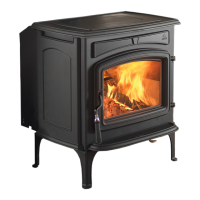16
139473_A 9/11/12
5.7 Adding Fuel
Follow this procedure when reloading the stove while it is
still hot and a bed of hot embers remains:
• Always wear gloves when tending to the stove.
• Adjust the Primary Air Shutter Lever to the fully open
position and open the baffle plate. Wait a few seconds to
re-establish strong draft before opening the load door. This
will allow fresh air to flush the firebox and prevent smoke
escaping when the door is opened.
• Open the door slightly, and hesitate a moment to allow
exhaust purge, then open the door fully.
• Use a stove tool or poker to evenly distribute coals and
embers around the firebox.
• Load the fuel, usually with smaller logs first.
• Close the door, being sure to latch the door tightly.
• Wait 5 – 10 minutes to re-establish the fire before
setting the air controls for the desired heat output and
burn time. (If there is at least a 2” thick ember bed
when reloading, it may be possible to close the door and
immediately adjust the air control setting).
• Set the Air Shutter for the desired heat output.
5.8 Open Door Fire-viewing
Warning: This stove should be operated with the door
either fully open with optional Spark Screen in place or
with the door fully closed. If the door is left partly open,
there is risk of overfiring. Also, gas and flame may be drawn
out of the fireplace stove opening, creating risks from both
fire and smoke.
Be aware that, when operating with the door open, there
exists the possibility of carbon monoxide generation by
charcoal, Good draft is essential to minimize the potential
for CO to be introduced into the living space. Be sure
adequate fresh air and ventilation are available to the stove
when using the spark screen.
WARNING:
NEVEROVER-FIRETHESTOVE.IFANYPARTOFTHE
STOVEORCHIMNEYGLOWS,YOUAREOVER-FIRING.
AHOUSEFIREORSERIOUSDAMAGETOTHESTOVE
ORCHIMNEYCOULDRESULT.IFTHISCONDITION
OCCURS,IMMEDIATELYCLOSETHEAIRCONTROL.
5.9 Creosote Formation and the
Need for Removal
When wood is burned slowly, it produces tar and other
vapors that combine with moisture to form creosote.
Creosote vapors condense in the relatively cool chimney
flue, and creosote residue accumulates on the flue lining.
When ignited, this creosote fuels an extremely hot fire.
The chimney connector and chimney flue should be
inspected at least bi-monthly during the heating season to
determine if creosote buildup has occurred.
If creosote has accumulated, it should be removed to reduce
the chance of a chimney fire.
In the event that creosote ignites in the flue, the resulting
fire is often accompanied by a roaring noise and crackling
sound as flakes of burning creosote break loose. If you
suspect you are having a chimney fire, immediately close
the air controls and make sure the door is closed securely.
Call the fire department and have everyone leave the house.
Do not attempt to extinguish the fire. Opening the door will
only supply additional oxygen and intensify the fire. When
the fire in the flue has subsided, resist the temptation
to open the door to check on the fire. The fire may have
suffocated, but could re-ignite with a supply of fresh air.
After a chimney fire, do not use the stove until the chimney
connector and flue have been cleaned and inspected to
ensure no damage has been sustained.
See Section 6.6 of this manual regarding chimney cleaning.
5.10 Ash Removal
Remove ashes whenever accumulation nears the primary
air port located inside the firechamber just under the door
opening.
Always wear safety gloves when handling the ashes.
Ashes should only be placed in a metal container equipped
with a tight sealing lid. The container should be placed on a
noncombustible floor or on the ground, well away from all
combustible materials, pending final disposal. If the ashes
are to be disposed of by burial in soil or otherwise locally
dispersed, they should be kept in the closed container until
all cinders have thoroughly cooled.

